3.11.2022
Saudi astronauts to fly on Ax-2 mission to ISS
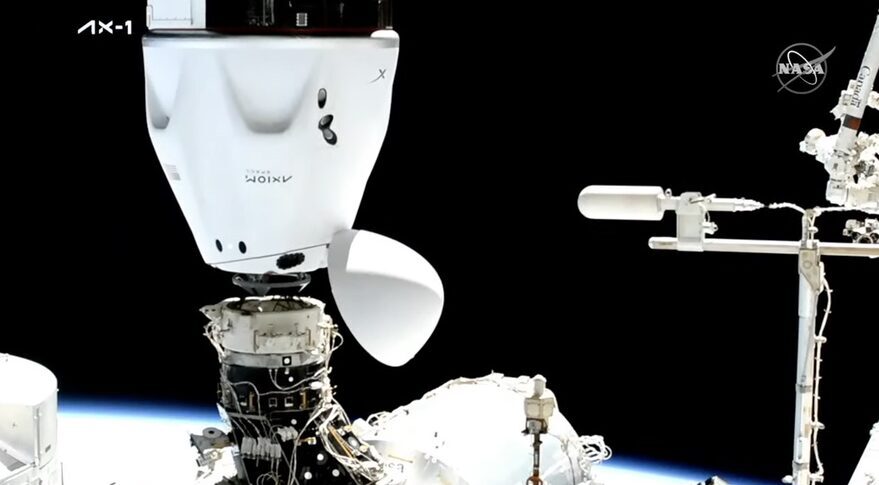
The Crew Dragon flying the Ax-1 mission to the ISS in April 2022. The next Axiom Space mission to the ISS, Ax-2, will include two Saudi private astronauts, NASA confirmed Nov. 1. Credit: NASA TV
WASHINGTON — NASA confirmed Nov. 1 that two astronauts from Saudi Arabia will go to the International Space Station on a private mission in the spring of 2023 operated by Axiom Space.
Speaking at a meeting of the NASA Advisory Council’s Human Exploration and Operations Committee, Angela Hart, manager of NASA’s commercial LEO development program, said that two Saudi mission specialists, yet to be publicly named, would accompany Peggy Whitson and John Shoffner on the Ax-2 mission, a Crew Dragon flight set to launch no earlier than May 1, 2023, to the station.
The names of the two Saudis on the flight have not been released, she said, but that “we are working very hard with them on training already.” A slide for her presentation noted the two would be named after formal approval by the ISS program’s Multilateral Crew Operations Panel. That slide also stated that crew training for the mission started Oct. 17.
The Saudi Space Commission and Axiom Space separately announced Sept. 22 plans to fly two Saudi citizens on a future Axiom Space mission. However, while it was widely rumored the two would fly on Ax-2, neither announcement stated a specific mission. The Saudi statement said that one of the two people would be a woman but did not disclose how the astronauts would be selected. The commission did not respond to questions at the time about the selection process.
The upcoming Ax-2 mission, Hart said, will be similar to the Ax-1 private astronaut mission that spent two weeks at the station in April. The 10-day mission will conduct commercial and non-profit research and other activities at the station.
“We learned a lot on the first mission,” she said. “We have completed updating a lot of our planning milestones and deliverables and timelines based on the Ax-1 lessons learned.”
Among the lessons incorporated for future missions is a new requirement that private astronaut missions be commanded by a former NASA astronaut with flight experience. NASA said in August it was adding that requirement based on experience from Ax-1, which was commanded by former NASA astronaut Michael López-Alegría, and “other recent civilian-crew spaceflight.”
The change does not apply to Ax-2, but Axiom had already named Whitson, a former astronaut, as commander. The requirement does apply to two future private astronaut missions that NASA solicited proposals for in September that would go to the ISS between late 2023 and the end of 2024.
Those proposals were due to NASA Oct. 27, Hart said, with selections expected late this year or early next year. In addition to the requirement about the mission’s commander, NASA instituted “stricter workday requirements,” she said, to address packed schedules, as well as built in time for crews to adapt to the station and to set up and tear down equipment.
Quelle: SN
----
Update: 14.02.2023
.
Saudi Arabia to send its first female astronaut into space
Rayyanah Barnawi and Ali Al Qarni will travel to the International Space Station later this year
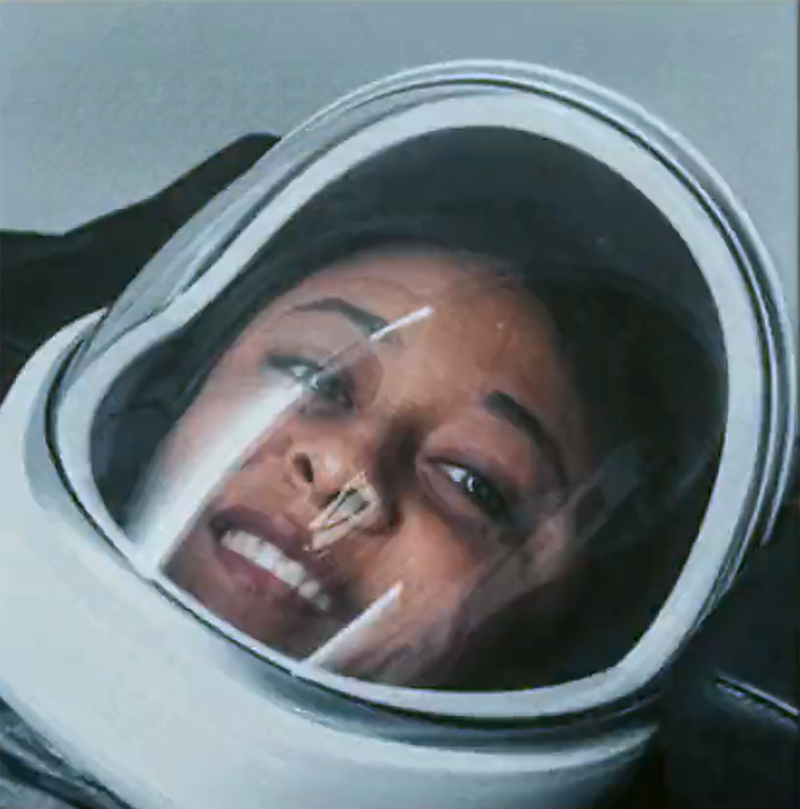
Rayyanah Barnawi is one of the astronauts who will fly on the AX-2 mission in Q2 of this year.
Saudi Arabia has announced it will send its first female astronaut into space later this year.
Rayyanah Barnawi will travel to the International Space Station (ISS) in the second quarter of this year, along with male astronaut Ali Al Qarni, the Saudi Press Agency said on Sunday.
They will be travelling as part of the AX-2 mission to the ISS, the Saudi Space Commission said on Twitter.
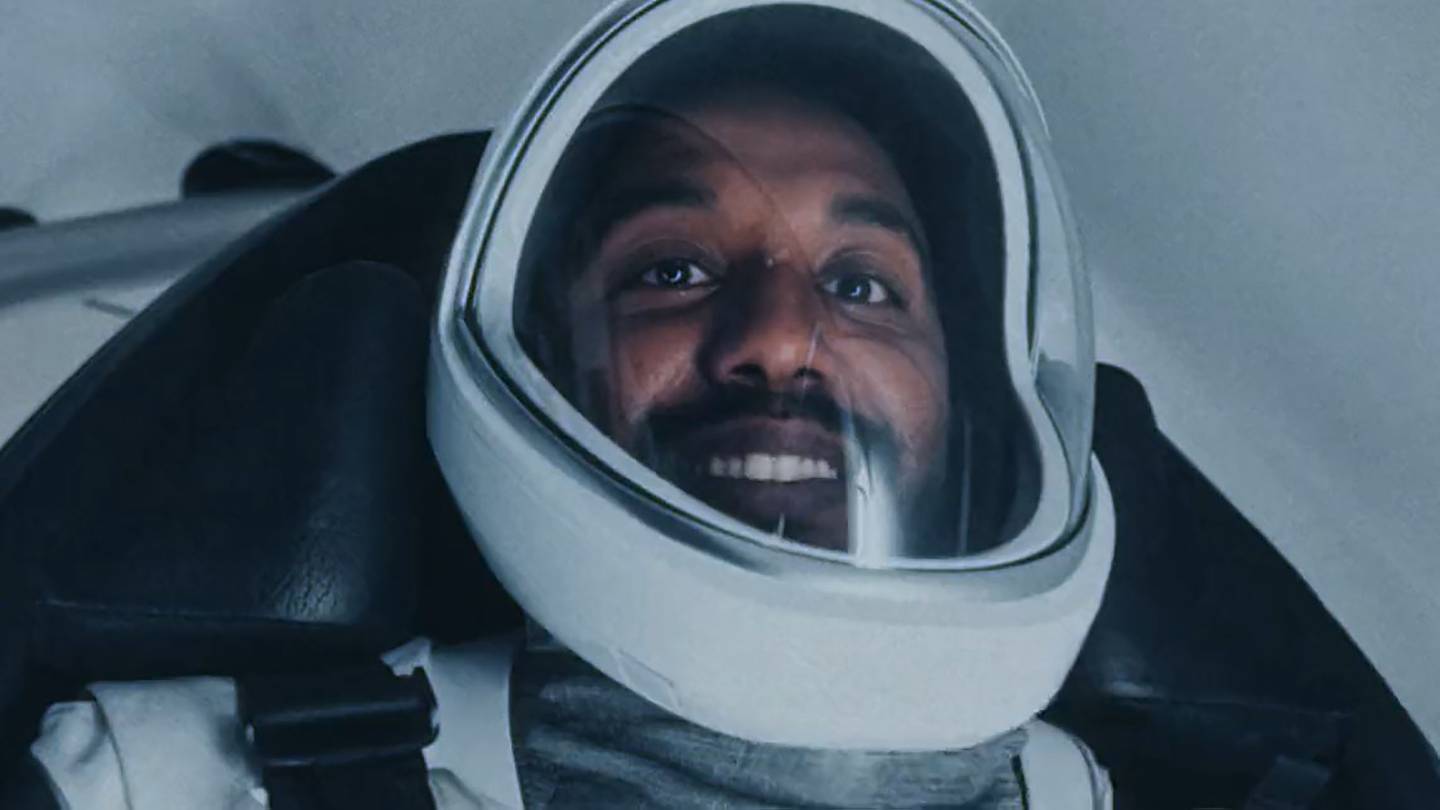
Ali AlQarni is one of the astronauts who will fly on the AX-2 mission in Q2 of this year.
“Every journey has its pioneers and every mission has its heroes,” read a Tweet from the commission.
Two more astronauts, Mariam Fardous and Ali Al Gamdi, will train on the Saudi Human Spaceflight Programme on all mission requirements.
“Through this programme, the kingdom seeks to activate scientific innovations at the level of space sciences, enhance its ability to independently conduct its own research that will reflect positively on the future of the industry and the country,” said Abdullah Bin Amer Al Swaha, chairman of the Saudi Space Commission.
“[It will] increase the interest of graduates in the fields of science, technology, engineering, and mathematics (Stem), and develop human capital by attracting talents and the necessary skills.”
The National reported last year how Emirati Sultan Al Neyadi could be joined on the ISS by two astronauts from Saudi Arabia.
Dr Al Neyadi, a former IT professor from Al Ain, will depart from the Kennedy Space Centre in Florida on February 26 for the six-month long mission.
The Saudi Arabian astronauts are expected to join the project for two weeks, Reuters reported in October.
Saudi Arabia's Prince Sultan bin Salman, an air force fighter pilot, became the first Arab in space in 1985.
Quelle: The National
+++
First Saudi woman astronaut to fly to International Space Station this year
Mission aims to empower national capabilities in human spaceflight
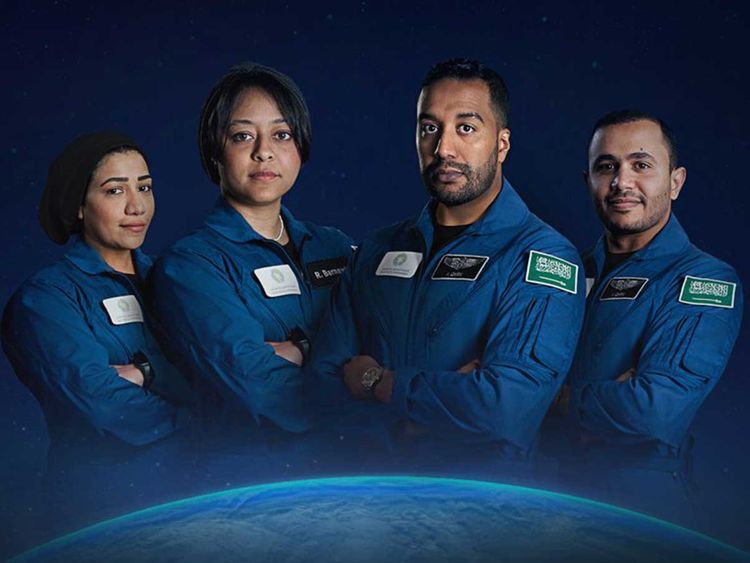
Rayyanah Barnawi and Ali AlQarni (Centre) will join the crew of the AX-2 space mission while Mariam Fardous (L) and Ali Al Gamdi (R) will also be trained on all the requirements of the mission. Image Credit: Saudi Space Commission
Dubai: Saudi Arabia announced on Sunday that it will be sending the first Saudi woman astronaut Rayyanah Barnawi and a Saudi male astronaut Ali AlQarni to the International Space Station (ISS) during the second quarter of 2023, Saudi Press Agency (SPA)reported. The two astronauts will join the crew of the AX-2 space mission, set to take off from the United States.
The mission, part of the Saudi Human Spaceflight Programme, aims to empower national capabilities in human spaceflight and contribute to scientific research in various fields, including health, sustainability, and space technology.
The programme also seeks to increase interest in STEM fields and attract talented individuals to develop human capital in the country.
Abdullah Bin Amer Al Swaha, Chairman of the Saudi Space Commission, stated that the Kingdom’s leadership is committed to supporting the space programme and contributing to scientific innovation in the field of space sciences.
The CEO of the Saudi Space Commission, Mohammed Bin Saud Al Tamimi, expressed gratitude for the support and empowerment provided by the leadership, which has enabled significant progress in the Kingdom’s space sector.
This mission is also a symbol of the country’s superiority and competitiveness in technology, engineering, research, and innovation. The Kingdom will become one of the few countries in the world to have two astronauts of the same nationality aboard the ISS simultaneously, marking a historic moment for the country.
The Saudi Space Commission’s programme is in cooperation with a group of entities, including the Ministry of Defence, Ministry of Sport, General Authority of Civil Aviation, King Faisal Specialist Hospital and Research Centre, and international partners such as Axiom Space, a leading provider of human spaceflights and space infrastructure development in the USA.
The Saudi Human Spaceflight Programme, previously launched by the Saudi Space Commission, is a comprehensive programme aimed at training and qualifying experienced Saudis to participate in future human spaceflights, conduct scientific experiments, and contribute to international research. This upcoming mission is a crucial milestone in the programme, aligning with the Kingdom’s Vision 2030.
Quelle: GULF NEWS
+++
NASA, Partners Clear Axiom’s Second Private Astronaut Mission Crew
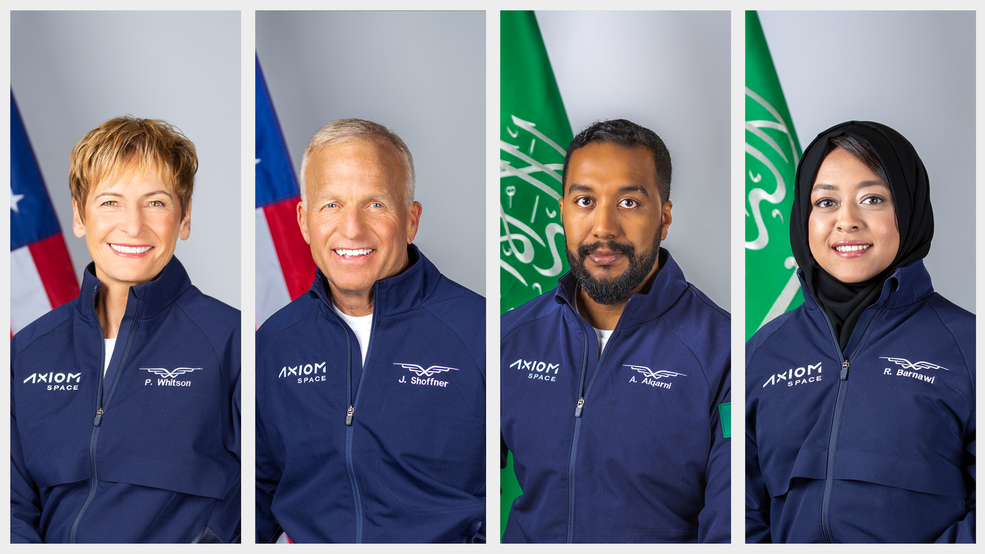
NASA and its international partners have approved the crew for Axiom Space’s second private astronaut mission to the International Space Station, Axiom Mission 2 (Ax-2).
Axiom Space’s Director of Human Spaceflight and former NASA astronaut Peggy Whitson will command the privately funded mission. John Shoffner of Knoxville, Tennessee, will serve as pilot. The two mission specialists, Ali Alqarni and Rayyanah Barnawi from the Kingdom of Saudi Arabia (KSA), are members of the inaugural Saudi national astronaut program. They are flying through an arrangement between KSA and Axiom Space.
“Enabling more people to go to space is an important component of NASA’s continuing efforts to grow the low-Earth orbit economy,” said Angela Hart, manager of NASA’s Commercial Low-Earth Orbit Development Program. “Private astronaut missions are a key component to enable a successful transition to a model of commercially owned and operated platforms in low-Earth orbit. I appreciate the commitment of our International Space Station and commercial partners to help us achieve this future.”
The Ax-2 crew will launch from NASA’s Kennedy Space Center in Florida aboard a SpaceX Dragon spacecraft and travel to the space station. Once docked, the private astronauts plan to spend 10 days aboard the orbiting laboratory implementing a full mission of science, outreach, and commercial activities. The mission, targeted for launch in spring 2023, will be the first private space mission to include both private astronauts and astronauts representing foreign governments, as well as the first private mission commanded by a woman.
“Axiom Space’s second private astronaut mission to the International Space Station cements our mission of expanding access to space worldwide and supporting the growth of the low-Earth orbit economy as we build Axiom Station,” said Michael Suffredini, president and CEO of Axiom Space. “Ax-2 moves Axiom Space one step closer toward the realization of a commercial space station in low-Earth orbit and enables us to build on the legacy and achievements of the station, leveraging the benefits of microgravity to better life on Earth.”
Whitson will become the first female commander of a private space mission, adding to her prior accomplishments, including as NASA’s chief astronaut and the first female commander of the space station. In addition, she will add to her standing record for the longest cumulative time in space by a NASA astronaut.
“I’m honored to be heading back to the station for the fourth time, leading this talented Ax-2 crew on their first mission,” said Whitson. “This is a strong and cohesive team determined to conduct meaningful scientific research in space and inspire a new generation about the benefits of microgravity. It’s a testament to the power of science and discovery to unify and build international collaboration.”
Shoffner, a businessman, has always had an interest in space, the stars, and flying, becoming a pilot at the age of 17 and since amassing than 8,500 flight hours and earning ratings for multiple aircraft types. He also is an advocate for science, technology engineering, arts, and mathematics (STEAM) education.
The first private astronaut mission to the International Space Station, Axiom Mission 1 (Ax-1), launched April 8, 2022, with four private astronauts who spent 17 days in orbit working on 26 science payloads aboard the station and conducting more than 30 STEAM educational and public outreach engagements. The crew splashed down off the coast of Florida on April 25, 2022, to conclude the mission.
Private astronaut missions to the space station are a precursor to privately funded commercial space stations as part of NASA’s efforts to develop a thriving low-Earth orbit ecosystem and marketplace. NASA is currently reviewing proposals for the third and fourth private astronaut missions to the space station.
For more than 22 years, NASA has supported a continuous U.S. human presence in low-Earth orbit aboard the space station. The agency's goal is to enable a strong, commercial marketplace in low-Earth orbit where NASA is one of many customers for private industry. This strategy will provide services the government needs at a lower cost, enabling the agency to focus on its Artemis missions to the Moon in preparation for Mars while continuing to use low-Earth orbit as a training and proving ground for those deep space missions.
Quelle: NASA
----
Update: 2.04.2023
.
NASA Updates Media on Next Private Astronaut Mission to Space Station
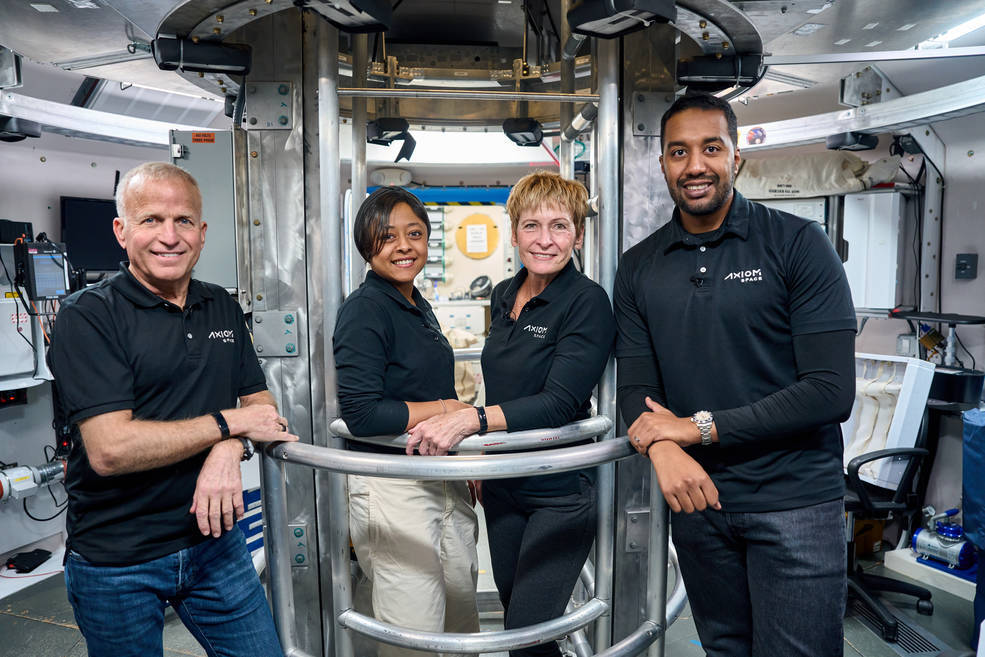
NASA experts will join a virtual press conference hosted by Axiom Space at 12 p.m. EDT Thursday, April 6, to preview the launch of Axiom Mission 2 (Ax-2), the second private astronaut mission to the International Space Station. The Ax-2 launch aboard a SpaceX Falcon 9 rocket and Dragon spacecraft is targeted for early May from Launch Complex 39A at NASA’s Kennedy Space Center in Florida.
During the mission, which includes 10 days aboard the space station, the four-person multi-national crew will complete more than 20 research experiments developed for microgravity in collaboration with organizations across the globe.
This press conference will be held virtually. Media must register for the mission overview press conference by 1 p.m., Wednesday, April 5, at:
Briefing participants are:
- Joel Montalbano, manager, International Space Station Program, NASA
- Angela Hart, Commercial Low-Earth Orbit Development Program manager, NASA
- Michael Suffredini, CEO and president, Axiom Space
- Peggy Whitson, Ax-2 commander, Axiom Space
- Mishaal Ashemimry, microgravity research lead, Saudi Space Agency
- Sarah Walker, director of Dragon Mission Management, SpaceX
Axiom Space astronauts Peggy Whitson, John Shoffner, Ali Alqarni, and Rayyanah Barnawi are prime crew members of the Ax-2 mission. Whitson, a former NASA astronaut, will serve as the mission commander. Shoffner of Knoxville, Tennessee, will serve as pilot. Alqarni and Barnawi, representing the Kingdom of Saudi Arabia, will be mission specialists.
NASA continues to make rapid progress in its efforts to build a robust low-Earth orbit economy. The agency recently announced its selection of Axiom Space for the third private astronaut mission to the space station. NASA’s commercial partners are also maturing designs to develop commercial space stations in low-Earth orbit.
Quelle: NASA
----
Update: 7.04.2023
.
Whitson, Ax-2 Crew Look to 8 May Night Launch to Space Station
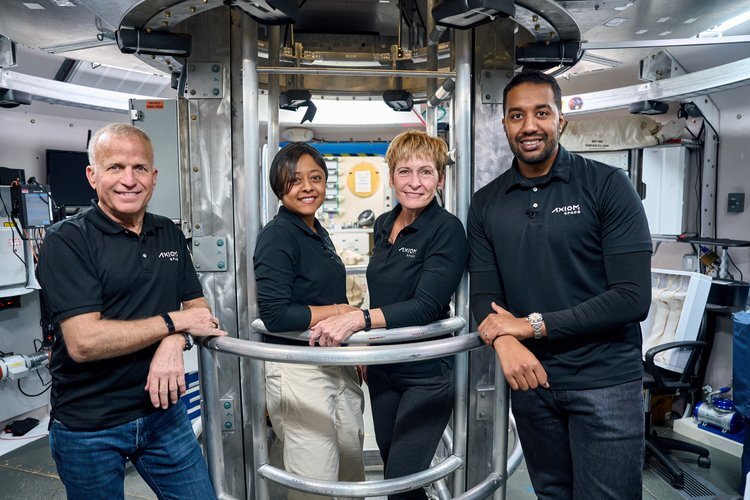
The Ax-2 crew, from left: Shoffner, Barnawi, Whitson and Al-Qarni. Photo Credit: AxiomSpace
Four spacefarers from two nations, including America’s most flight-seasoned astronaut, will launch from historic Pad 39A at the Kennedy Space Center (KSC) in Florida no sooner than 10:43 p.m. EDT on Monday, 8 May, for a privately-financed mission to the International Space Station (ISS) on behalf of Houston, Texas-based AxiomSpace, Inc. Former NASA Chief Astronaut Peggy Whitson—who logged more than 665 days in orbit across three flights to the station, including a 9.5-month increment between November 2016 and September 2017—spoke to the media on Thursday, alongside senior leaders from NASA, SpaceX, AxiomSpace and the Saudi Space Commission (SSC), to discuss what AxiomSpace CEO Michael Suffredini calls “a very full mission for the crew”.
Whitson’s association with Ax-2 first entered the public consciousness in January 2021, when she was assigned to back up former shuttle astronaut and veteran ISS commander Mike Lopez-Alegria in his command of Ax-1, the first all-private mission to the station. Having retired from NASA’s Astronaut Corps in June 2018, Whitson joined AxiomSpace, where she now serves as its head of human spaceflight.
“Not the first time I have backed up @CommanderMLA,” Whitson tweeted at the time, harking back to her 2006-2007 stint as backup to Lopez-Alegria’s Expedition 14 mission. “The next best thing to flying in space is training for it.
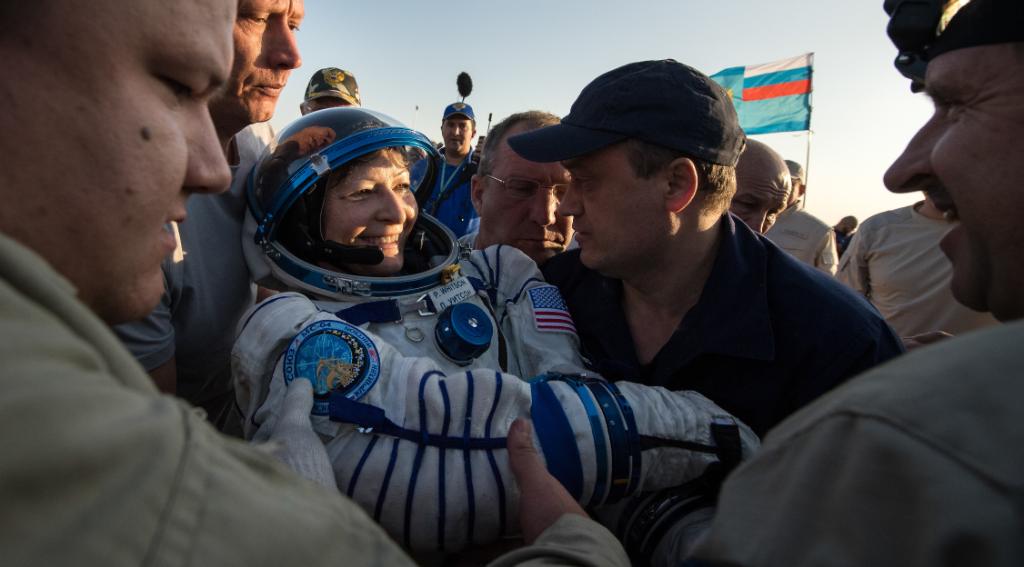
Late in the spring of 2021, she was announced to command Ax-2, with airshow pilot, athlete and motorsports endurance racer John Shoffner of Knoxville, Tenn., as pilot. The following December, NASA and AxiomSpace formally signed the mission order that Ax-2 would fly no sooner than late 2022 or early 2023, with an expectation that Whitson and her crew would spend “no more than 14 days docked” to the station. In its mission order, NASA noted that Ax-2 is also charged with bringing home scientific samples “that must be kept cold in transit back to Earth”, as well as a Nitrogen/Oxygen Recharge System (NORS) tank, potentially two late-return cargo transfer bags and will include “up to ten hours of the private astronaut mission commander’s time during the docked mission to complete NASA science or perform tasks for NASA”.
By last August—with the 17-day Ax-1 mission having triumphantly flown last April—Ax-2’s launch date was shifted slightly to the second quarter of 2023, with a revised estimate that Whitson’s crew will now spend around ten days on the ISS. Last September, AxiomSpace contracted with the Saudi Space Commission (SSC) to fly the Kingdom of Saudi Arabia’s second male astronaut and first female astronaut to the ISS “no earlier than 2023”.
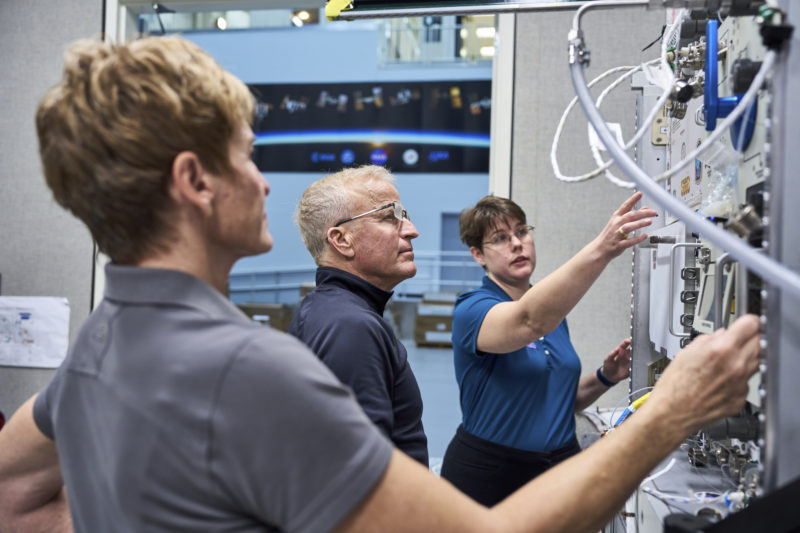
With Ax-2 having been approved by NASA and its International Partners (IPs) last January, the announcement of the two Saudi crew members finally came in mid-February. Named were Rayyanah Barnawi, a biomedical scientist and laboratory technician, with expertise in breast cancer and stem-cell research, and Ali Al-Qarni, an aerospace engineer and Royal Saudi Air Force (RSAF) captain and fighter pilot.
Speaking about her crew, Whitson noted that they have not only “met, but surpassed the training requirements”. She added that Shoffner “always has a story to tell” and that his work on Ax-2 will emphasize Science, Technology, Engineering, Arts and Mathematics (STEAM) education and praised the “extremely meticulous style” of Barnawi as well as Al-Qarni’s “savvy discipline”.
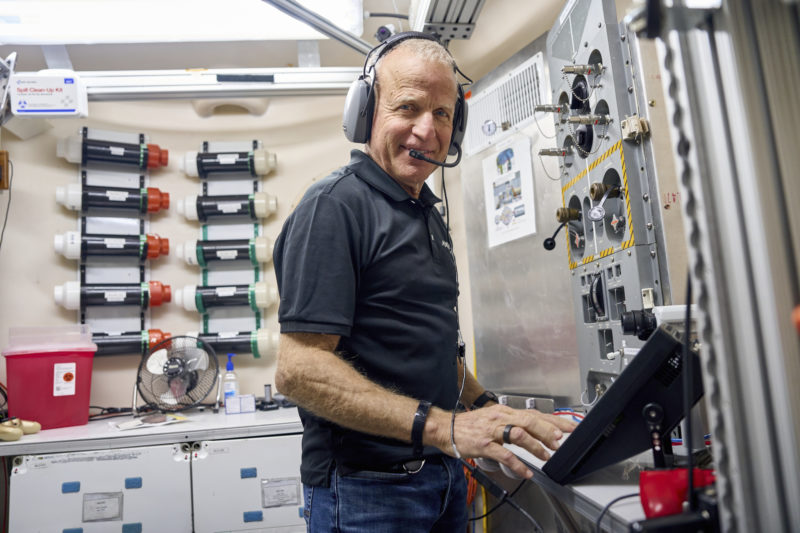
Ax-2 will facilitate more than 20 multidisciplinary experiments spanning the life sciences, human research, physical sciences and technology demonstration fields. Additionally, the mission carries a number of STEAM outreach investigations, with an expectation that Whitson’s crew will support about 130 cumulative hours of National Lab Science during their ten days aboard the sprawling orbital outpost.
Key technology demonstrations aboard Ax-2 include sensors to detect odors in the ISS pressurized environment, an experimental mobile communications device, a wireless transfer application to automatically downlink imagery, a smart stowage and inventory management video system and a novel intravehicular “skin-suit”, worn by the astronauts, which will simulate several aspects of terrestrial gravity to mitigate negative factors such as spinal elongation, muscle atrophy and sensorimotor changes.
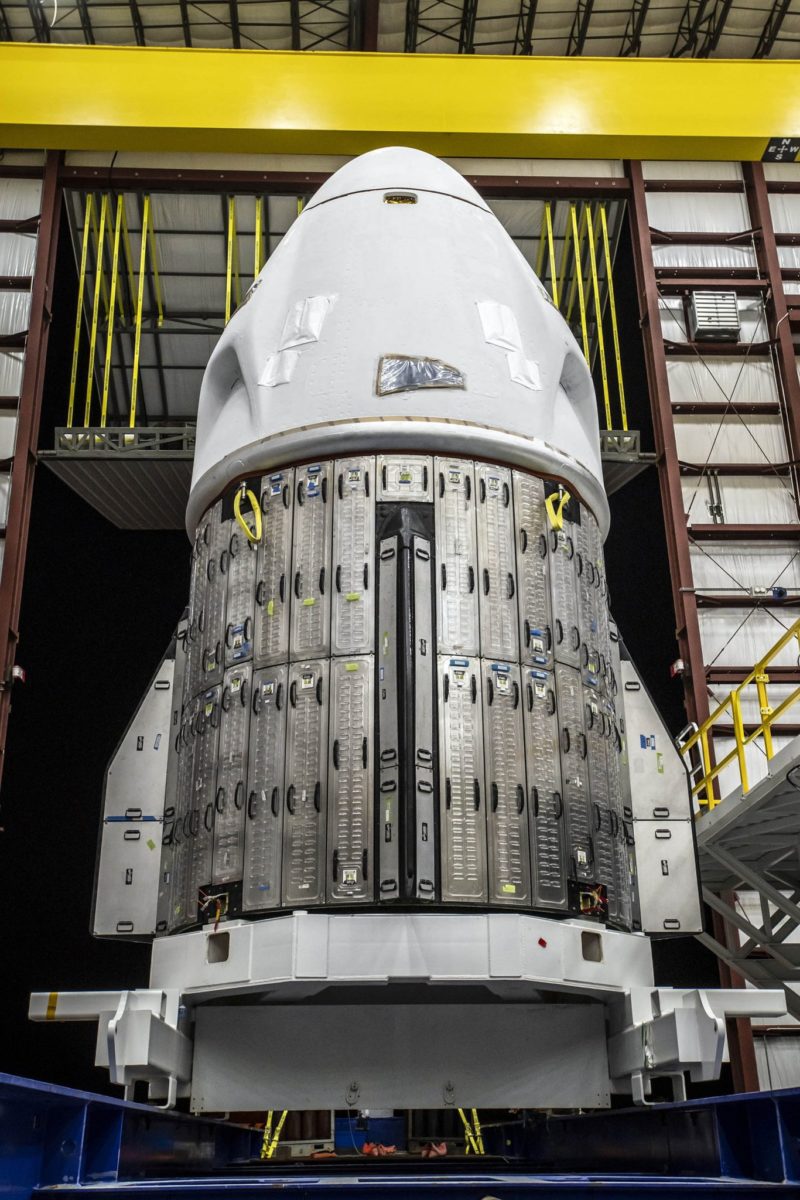
In the physical sciences arena, Ax-2 will examine the concept of “cloud seeding”—the artificial inducement of rainfall by implantation of silver iodide crystals in clouds—in the microgravity environment. Developed jointly between NanoRacks, the SSC and King Fahd University of Petroleum and Minerals, the experiment will mix moist air and silver iodide crystals in a reaction chamber as part of efforts to develop weather-control technologies for future human settlements on the Moon and Mars.
Other investigations will test a new hydrogen-rich polymer in the ISS internal radiation environment to assess its shielding capabilities and Ax-2 astronauts will also acquire imagery through the windows of the station’s cupola to study lightning and other atmospheric phenomena, including sprites, blue jets and elves. This experiment will also engage students in the Middle East, Africa, Asia and the Americas.
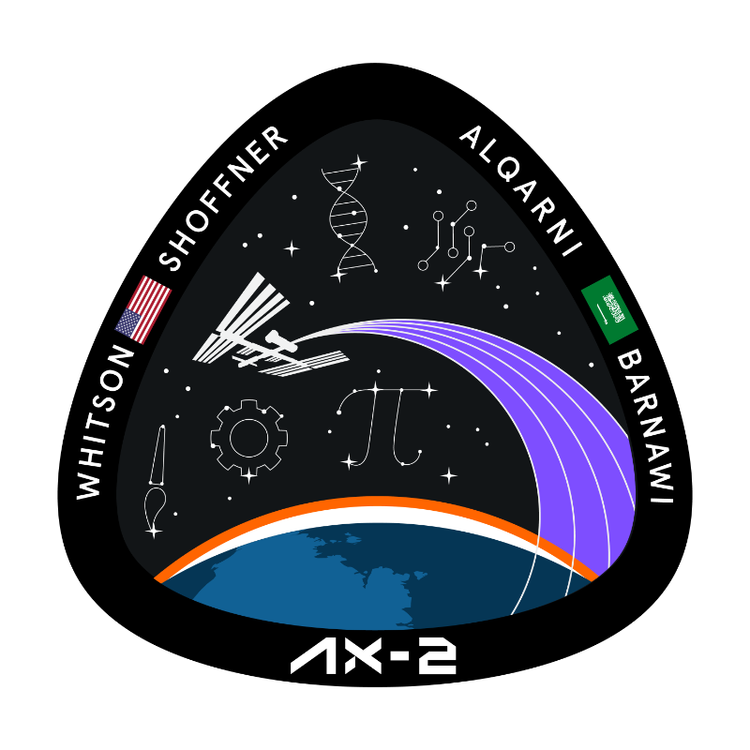
Further emphasizing the STEAM-focus of Ax-2, the mission will also include usage of the Amateur Radio on the ISS (ARISS) hardware to facilitate ham radio contact with students in classrooms or public forums around the world. And Saudi students will participate in experiments looking at the aerodynamic behavior of different-shaped kits on the space station, performing their own ground-based activities in tandem.
In the life sciences, Ax-2 will seek to optimize the assembly of DNA-based nanomaterials for potential therapeutic use, investigate the effect of the microgravity environment upon the production of stem cells and derived products, explore the inflammatory response of human immune cells, conduct cancer research and examine bioengineered liver and kidney tissue constructs. The Translational Research Institute for Space Health (TRISH), a partnership between NASA’s Human Research Program (HRP) and an academic consortium including Baylor College of Medicine in Houston, Texas, the California Institute of Technology in Pasadena, Calif., and Massachusetts Institute of Technology in Cambridge, Mass., has also provided a battery of tests, physical assessments, questionnaires, biological sampling sessions and wearable devices to monitor the Ax-2 crew’s adaptation to microgravity and their capacity to perform cognitively demanding work.
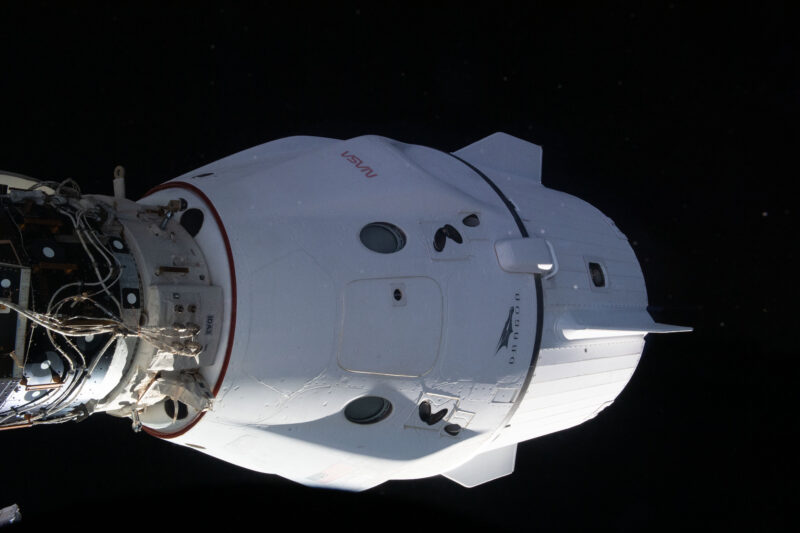
Backing up Whitson’s prime crew shadowing them “on all mission requirements” will be Mariam Fardous, a medical doctor and the first Arab women to dive at the North Pole, and Al Al-Ghamdi, who is, like Al-Qarni, a captain in the RSAF. “This is a strong and cohesive team determined to conduct meaningful scientific research in space and inspire a new generation about the benefits of microgravity,” said Whitson. “It’s a testament to the power of science and discovery to unify and build international collaboration.”
The backup mission commander is Mike Lopez-Alegria, who previously led Ax-1, with Italian Air Force Col. Walter Villadei as pilot. Villadei was identified as Ax-2’s backup pilot in May of last year, when AxiomSpace and the Italian Government signed a Memorandum of Understanding (MoU) to formally begin his training.
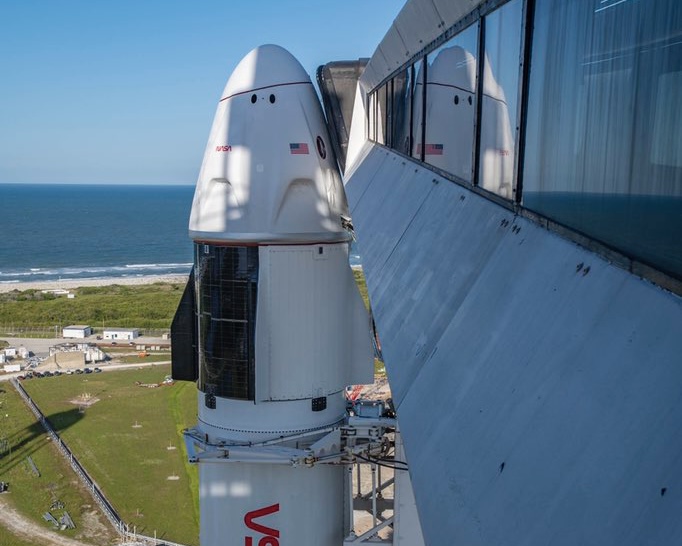
Whitson, Shoffner, Barnawi and Al-Qarni will fly aboard SpaceX’s Dragon Freedom, which will be embarking on her second trek to the ISS, having supported the 170-day Crew-4 mission between April and October of last year. This proved no surprise, since her three operational sisters are all otherwise engaged: Dragon Endeavour is currently on-orbit, supporting Crew-6 at the space station, whilst Dragon Endurance returned just last month from her five-month-long Crew-5 dutyand Dragon Resilience is earmarked for the high-orbiting “Polaris Dawn” mission this summer.
Assuming an on-time launch at 10:43 p.m. EDT on Monday, 8 May—atop a brand-new Falcon 9 booster, whose tail-number is as yet unidentified—Whitson and her crew will follow a roughly 37-hour rendezvous profile, ahead of Dragon Freedom executing an autonomous docking at the ISS at 11:40 a.m. EDT on Wednesday, 10 May. Due to the complexities associated with orbital dynamics and trajectory requirements, a launch on Tuesday 9th will produce a docking at the same time on Wednesday.
Quelle: AS
